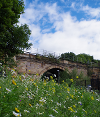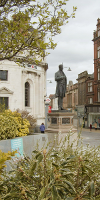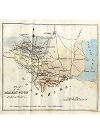Our story
S&DR200 is a 9-month international festival taking place across County Durham and Tees Valley in 2025, to celebrate the 200th anniversary of the first journey on the Stockton and Darlington Railway (S&DR).
S&DR200 is delivered by Darlington Borough Council, Durham County Council and Stockton-on-Tees Borough Council. S&DR200 is part of Railway 200, a nationwide campaign celebrating 200 years of train travel.
The festival team is working with internationally and nationally renowned artists, makers, filmmakers, curators, historians, and local creatives, and communities to create a rich and varied festival programme.
Visitors of all ages will enjoy immersive art installations and augmented-reality digital games, see treasured artworks in the region for the first time, join thousands of others for awe-inspiring outdoor events and see some of the world's favourite locomotives.
Rail enthusiasts and budding historians will be able to hear from experts in their fields and we will delve into the future of travel with our industry partners. Local children will enjoy hands-on creative workshops and young people, local communities and arts organisations will create special events for the festival.
Whether you are a railway buff, someone who loves getting creative, or enjoy new cultural experiences - there will be something for you.
The full programme will be announced in September 2024.
Sign up to our newsletter to make sure you don't miss any updates.
Celebrating the region's heritage

Celebrating the region's heritage
The festival team and partners are looking forward to celebrating the region's pioneering heritage in new and unusual ways, ensuring the story of the S&DR is still being told in another 200 years.
The importance of the birth of modern railways cannot be overstated. Railways are a fundamental part of the global economy and part of daily life for people across the world. The 200th anniversary presents a once-in-a-lifetime opportunity to connect directly with hundreds of thousands of people from all walks of life, to promote the products, businesses and services that echo the inventiveness and life-enhancing value of the railways and the North East of England.
Reuben Kench, Chair of the S&DR200 Board.
The history of S&DR

The history of S&DR
In 1818 Edward Pease, a retired wool merchant from Darlington and a prominent Quaker invited influential business owners to discuss the best option for transporting coal out from the collieries of south Durham. An earlier idea for a canal was dismissed and a report was commissioned from a Welsh engineer, George Overton, to survey a horse-drawn railway. The Stockton & Darlington Railway company (S&DR) was formed and plans were made to raise capital and get permission to build the line.
To cross 26 miles of land owned by numerous people was a huge undertaking. The directors of S&DR applied for a private Act of Parliament which would give them the powers to compulsory purchase land for the railway. After some opposition by landowners, the Stockton & Darlington Railway Act passed in April 1821. This Act not only allowed the S&DR to be built, but it put forward the idea of a 'mainline' with 'branches', describing what we now recognise as a network. It also listed a wide range of goods that could be carried, including coal, minerals, and agricultural and manufactured products. Unlike smaller, earlier private railways the S&DR was setting out a vision of what railways could be, a publicly accessible and expanding communications network.
At the same time Pease had met with leading engineer of the time George Stephenson. Stephenson had been designing locomotives since 1814. Stephenson put forward a convincing argument for steam power instead of horsepower. He was appointed by the S&DR committee to propose a revised route more suitable for locomotives. A second highly significant Act of Parliament was then passed in 1823 to allow the use of steam locomotives and the carrying of passengers on the S&DR.
In 1823 Pease and Stephenson together with George's son Robert and Thomas Richardson (another S&DR director) set up Robert Stephenson & Co. in Newcastle-upon-Tyne, the first company in the world established to build railway engines. S&DR commissioned the company to design and build several locomotives, including Locomotion No. 1 (formerly named Active) which was the first locomotive used on the S&DR.
The first public journey on the S&DR took place on 27 September 1825 from Shildon to Stockton, via Darlington. It had been tested prior to this, but on this date the locomotive Locomotion No. 1 pulled several waggons of coal and goods, and a carriage called Experiment with fare-paying passengers. Nearly 600 people (not all fare-paying passengers) were clinging to the train by the time it arrived at Stockton harbour.
This momentous journey of 26 miles led to the birth of the modern railway.

The first line connected collieries near Shildon to Darlington and the River Tees at Stockton Harbour. Over the next five years further branch lines were established. By 1830 the line was extended to a new deep-water port at Middlesbrough, the world's first planned railway town. The world's earliest known purpose-built wayside station had opened at Heighington in 1827.
Timothy Hackworth who had been appointed superintendent of locomotives at S&DR, oversaw advances in the technology and reliability of the engines. Engineers from France, Prussia (which included parts of modern-day Germany, Russia, Poland, Denmark, Belgium, and the Czech Republic) and the USA were hosted, taking away ideas to start planning and building railways across the world.
The success of steam engines on the S&DR persuaded the directors of the Liverpool and Manchester Railway (L&MR) to hold a competition to find the best locomotives for use on a new railway between the two cities (both were major manufacturing centres at that time). In 1829 the speed trials took place at Rainhill, Lancashire (now Merseyside). The Rainhill Trials catalysed many years of continued ingenuity in rail engineering. George and Robert Stephenson, and Timothy Hackworth were among the competitors of the nine-day competition. The Trials tested a variety of self-propelled steam locomotives for use on the L&MR. Robert Stephenson's locomotive Rocket was the winner and the L&MR opened on the 15 September 1830. It was a significant step forward in incorporating all the lessons learned by the S&DR and moving railway history forward into a new era.
S&DR had played a vital role in the railway revolution which led to the spread of railways worldwide, changing how the world travelled, traded, and communicated. The opening of S&DR was publicly celebrated in 1875, 1925 and 1975 and the S&DR200 Festival will mark its 200th anniversary.
Image credits are Joseph Pease Statue in Darlington by Lonely Tower Film & Media and Map in 1821 S&DR prospectus, courtesy of The Common Room.




